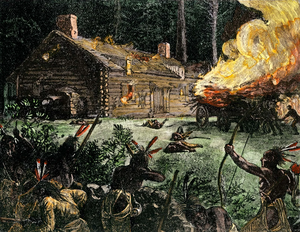
Back حرب الملك فيليب Arabic Kral Filip müharibəsi Azerbaijani Вайна караля Філіпа Byelorussian Война на Крал Филип Bulgarian Guerra del Rei Philip Catalan Válka krále Filipa Czech Kong Philips krig Danish King Philip’s War German Guerra del rey Felipe Spanish Kuningas Philipin sota Finnish
| King Philip's War | |||||||
|---|---|---|---|---|---|---|---|
| Part of the American Indian Wars and the European colonization of the Americas | |||||||
 A 19th-century colored wood-cut depicting a Native American attack on a settlement | |||||||
| |||||||
| Belligerents | |||||||
| Commanders and leaders | |||||||
| Strength | |||||||
| c. 3,500 | c. 3,500 | ||||||
| Casualties and losses | |||||||
| c. 3,000+[2] | c. 2,000+[3] | ||||||
| Part of a series on |
| Native Americans in the United States |
|---|
| Wars of Restoration England |
|---|
 |
King Philip's War (sometimes called the First Indian War, Metacom's War, Metacomet's War, Pometacomet's Rebellion, or Metacom's Rebellion)[4] was an armed conflict in 1675–1676 between a group of indigenous peoples of the Northeastern Woodlands against the English New England Colonies and their indigenous allies. The war is named for Metacom, the Pokanoket chief and sachem of the Wampanoag who adopted the English name Philip because of the friendly relations between his father Massasoit and the Plymouth Colony.[5] The war continued in the most northern reaches of New England until the signing of the Treaty of Casco Bay on April 12, 1678.[6][7]
Massasoit had maintained a long-standing alliance with the colonists and Metacom (c. 1638–1676), his younger son, became the tribal chief in 1662 after his father's death. Metacom, however, forsook his father's alliance between the Wampanoags and the colonists after repeated violations by the latter.[8] The colonists insisted that the 1671 peace agreement should include the surrender of Native guns; then three Wampanoags were hanged in Plymouth Colony in 1675 for the murder of another Wampanoag, which increased tensions.[9] Native raiding parties attacked homesteads and villages throughout Massachusetts, Rhode Island, Connecticut, and Maine over the next six months, and the colonial militia retaliated. The colonies assembled the largest army that New England had yet mustered, consisting of 1,000 militia and 150 Native allies. Governor Josiah Winslow marshaled them to attack the Narragansetts in November 1675. They attacked and burned Native villages throughout Rhode Island territory, culminating with the attack on the Narragansetts' main fort in the Great Swamp Fight. An estimated 600 Narragansetts were killed, and their coalition was taken over by Narragansett sachem Canonchet. They pushed back the borders of the Massachusetts Bay, Plymouth, and Rhode Island colonies, burning towns as they went, including Providence in March 1676. However, the colonial militia overwhelmed the Native coalition. By the end of the war, the Wampanoags and their Narragansett allies were almost completely destroyed.[10] On August 12, 1676, Metacom fled to Mount Hope where he was killed by the militia.
The war was the greatest calamity in seventeenth-century New England and is considered by many to be the deadliest war in Colonial American history.[11] In the space of little more than a year, 12 of the region's towns were destroyed and many more were damaged, the economy of the Plymouth and Rhode Island Colonies was all but ruined and their population was decimated, losing one-tenth of all men available for military service.[12][a] More than half of New England's towns were involved in the conflict.[14] Hundreds of Wampanoags and their allies were publicly executed or enslaved, and the Wampanoags were left effectively landless.[15]
King Philip's War began the development of an independent American identity. The New England colonists faced their enemies without support from any European government or military, and this began to give them a group identity separate and distinct from Britain.[16]
- ^ Rebecca Beatrice Brooks (May 31, 2017). "History of King Philip's War". Retrieved November 12, 2021.
- ^ Elson, Henry William (1904). "VI. Colonial New England Affairs: King Philip's War". History of the United States of America. New York: The MacMillan Company. Retrieved August 31, 2020.
- ^ Cray, Robert E. Jr. (2009). "'Weltering in their own blood': Puritan Casualties in King Philip's War". Westfield State University.
- ^ Faludi, Susan (September 7, 2007). "America's Guardian Myths". Opinion. The New York Times. Retrieved September 6, 2007.
- ^ Lepore.
- ^ Olivares, Jaime Ramon (2011). "Casco, Treaty of". In Tucker, Spencer (ed.). The Encyclopedia of North American Indian Wars, 1607–1890: A Political, Social, and Military History. ABC-CLIO. p. 134.
- ^ Norton.
- ^ Silverman, David (2019). This Land Is Their Land. New York: Bloomsbury Publishing. p. 298.
- ^ Silverman, pp. 295–298.
- ^ King Philip's War – British-Native American Conflict at the Encyclopædia Britannica
- ^ Drake, pp. 1–15.
- ^ Gould, Philip (Winter 1996). "Reinventing Benjamin Church: Virtue, Citizenship and the History of King Philip's War in Early National America". Journal of the Early Republic. 16 (4): 645–657. doi:10.2307/3124421. JSTOR 3124421.
- ^ Schultz and Tougias.
- ^ Cite error: The named reference
colonialwarsctwas invoked but never defined (see the help page). - ^ Silverman, pp. 348–353.
- ^ Lepore, pp. 5–7.
Cite error: There are <ref group=lower-alpha> tags or {{efn}} templates on this page, but the references will not show without a {{reflist|group=lower-alpha}} template or {{notelist}} template (see the help page).